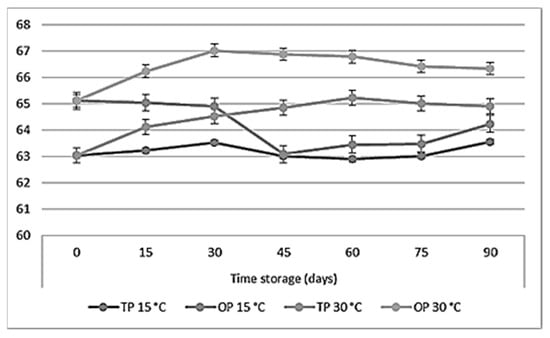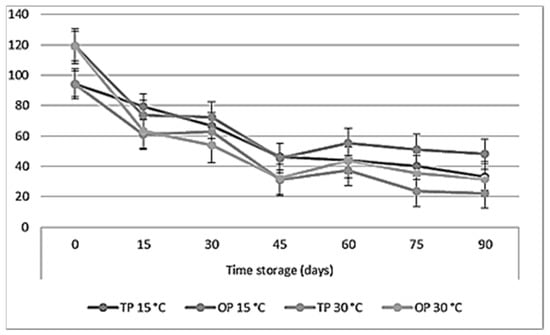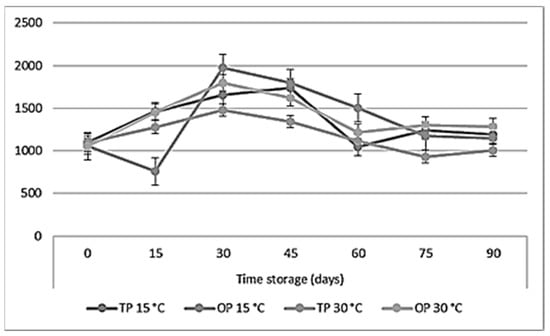Abstract
The aim of the present study was to assess the effect of treatment and storage period on the nutritional quality of enriched orange jam during storage for 90 days at 15 and 30 °C. The jam was produced by traditional technique using traditional pectin (TP) and with addition of orange peel (OP). All samples were evaluated for pH, total soluble solids, acidity, total phenolic content, total carotenoid content and antioxidant activity (DPPH and ABTS assay). The mean values at T0 of total soluble solids, titratable acidity and pH of TP jam samples were 63.03 °Brix, 0.60% and 3.51, respectively. While the values for OP jam samples were 65.11 °Brix, 0.61% and 3.68, respectively. The polyphenols ranged from 83.44 to 126.22 mg/100 g for control samples and from 125.12 to 171.02 mg/100 g for enriched jam. As regards temperature storage, the enriched jam stored at 15 °C maintained better analytical parameters than the samples stored at 30 °C. The results obtained from the experimentation show that use of orange peels in orange jam preserved the functional characteristics during storage.
1. Introduction
The genus Citrus of the family Rutaceae includes several important fruits such as oranges, mandarins, limes, lemons, sour orange and grapefruits. Citrus fruits are one of the important crops, with worldwide production of over 80 million tons per year [1].
Citrus fruits are an important source of bioactive compounds. In particular, citrus peels contain significant amounts of phenolic compounds especially phenolic acids and flavonoids [2].
Citrus by-products are secondary product derived from the industrial process of citrus fruits and constitute about 50% of fresh fruit weight [3,4].
Citrus peel is a very much sought after product in the citrus industry. The most important component of citrus peel is hesperedin, but peel also contains other bioflavonoids, as naringin, diosmin, and neohesperidin. Furthermore, citrus peel contains pectin and has a high vitamin content [5].
A modern industry for the production of citrus derivatives must fully exploit the fruit with the production of all possible derivatives. In the production process of citrus derivatives, such as essence and juice, the peels are a production waste [3].
Orange jam, among other orange derivatives, is a viable alternative to the economic exploitation of fruits, adding value to the fruit and promoting access to its beneficial constituents for the entire year. Adding the orange peel will enhance the flavor of the jam and it will also act as a natural thickening agent.
Considering the large amounts of by-products derived from orange processing, which are generally discarded, the present study aimed to explore the feasibility of using dry (Citrus × sinensis) peel for orange jam production and to evaluate the shelf life of the product.
2. Experiments
2.1. Preparation Orange Jam
Orange fruits Navel variety were bought from a local market and, after washing the oranges with warm water, to remove all impurities, were manually peeled using a potato peeler, eliminating the albedo and flavedo. The peels were dried in the sun and then ground with a laboratory blender.
Jam was produced according to the traditional method using oranges as a raw material. The formulation consisted of oranges pulp, sugar and pectin. Two types of jam were prepared: One with traditional pectin (TP) and one with orange peel (OP). When the total soluble solids reached 60 °Brix, then the orange peel (3%) and commercial pectin were added. Then the mixture was cooked until the total soluble solids reached 67 °Brix.
Both jams were boiled for 30 min before being placed in 300 mL glass jars. Afterwards, the jam jars were pasteurized at 65 °C for 30 min.
The jams were divided into two groups: One stored at 15 °C and the other at 30 °C. All samples were stored for a total of 90 days. An analytical determination was carried out every 15 days.
2.2. Chemical Analysis of Orange Jam
2.2.1. pH, Acidity and Total Soluble Solids
The pH was measured in sample juices by pH meter (Basic Model 20, Crison) and the total titratable acidity (TA) was assessed by titration with NaOH (0.1 N) to pH 8.1 and expressed as citric acid %. The total soluble solids (TSS) in the jam was estimated by a digital refractometer PR-201α (Atago, Tokyo, Japan) and expressed as °Brix at 20 °C.
2.2.2. Total Phenolic and Carotenoid Content
The total phenolic content of Citrus fruit juices was determined by the Folin–Ciocalteu method [6]. An aliquot of 500 μL of juice was mixed with 1ml of Folin–Ciocalteu reagent and 10 mL of 20% Na2CO3. The absorbance was measured at λ = 760 nm using a UV–Vis Agilent 8453 spectrophotometer (Agilent Technologies, Milan, Italy) after 2 h in the dark. The results were expressed as gallic acid equivalents (GAE) in mg/100 mL.
The total carotenoid content (TCC) was determined as previously described [7]. Briefly, extract was added to NaCl 5% solution, vortexed for 30 s and centrifuged at 4500 rpm for 10 min. The supernatant (100 μL) was diluted with 0.9 mL of n-hexane and measured at 460 nm. TCC was expressed as mg β carotene equivalents/g FW.
2.2.3. Antioxidant Activity
DPPH
The antioxidant activity was determined using DPPH free radical assay [8]. An aliquot of 2.5 mL of 0.06 mM DPPH methanolic solution was added to 50 μL of orange jam. The absorbances at t0 and t5 were measured at λ = 515 nm using a UV–Vis Agilent 8453 spectrophotometer (Agilent Technologies, Italy). The results were expressed according the following equation:
where Af = absorbance DPPH fruit juice at t = 5 min and A0 = absorbance DPPH (control) at t = 0 min. All tests were run in triplicate and the results expressed as means ± standard deviation (SD). Trolox was used as a standard antioxidant and juice activity was expressed in mM of Trolox equivalents.
(%) Inhibition = (1 − Af/A0) × 100
ABTS
The radical scavenging capacity of the samples for the ABTS (2,2′-azinobis-3-ethylbenzothiazoline-6-sulfonate) radical cation was determined as described by Re et al. [9]. ABTS was generated by mixing 7 mM of ABTS and 140 mM of K2S2O8 (potassium persulfate), followed by storage in the dark at room temperature for 16 h before use. The mixture was diluted (1:80) with ethanol to give an absorbance at 734 nm using the spectrophotometer. Each sample was diluted with 100 μL of was allowed to react with fresh ABTS solution (900 μL), and then the absorbance was measured 6 min after initial mixing. All measurements were performed in triplicate.
Statistical Analysis
All the experiments were conducted in triplicate, and the results were given as mean value ± standard deviation. Analysis of variance was performed by ANOVA and the difference between the means were analyzed using Tukey test.
3. Results
The pH value is significant indicator factor to obtain optimum gel condition. Table 1 shows the changes in pH values for jam prepared with traditional pectin (TP) and orange peel (OP) during storage at the two different temperatures.

Table 1.
pH of orange jam during storage at different temperature.
Changes in pH values of pH for TP and OP jam at different temperatures during storage are presented in Table 1. It can be said that pH values decreased significantly (p < 0.01) during storage regardless of storage temperature. The samples with orange peel added showed pH values that ranged from 3.61 and 3.41. In contrast, the traditional jam showed the highest pH values, which ranged from 3.68 and 3.51 at the end of storage.
As can be seen in Figure 1, the addition of orange peel to jam affected the content of TSS. In particular, TSS values examined ranged from 63.03 to 63.55 °Brix for TP jam at 15 °C and 63.03–64.89 °Brix at 30 °C. While TSS values fluctuated from 65.11 to 65.23 °Brix for OP jam at 15 °C and 65.11 to 66.33 °Brix at 30 °C.

Figure 1.
Total soluble solids (TSS) of orange jam during storage at different temperatures. TP = jam prepared with traditional pectin and OP = jam prepared with orange peel.
According to pH values, all samples showed an increase of pH value during storage (Table 2).

Table 2.
Titratable acidity (g/100 g acid citric) of orange jam during storage at different temperatures.
The change in total polyphenol values after treatments and during storage is reported in Table 3. Total polyphenol content at T0 was 83.44 mg/100 g and 125.12 mg/100 g for TP and OP jam, respectively. At the end of storage (90 days), the samples with orange peel added showed the best results in terms of polyphenol content regardless of storage temperature.

Table 3.
Total polyphenol content (mg GAE/100 g) in orange jam with different temperatures and storage times.
The effect of storage on the total carotenoid content is shown in Table 4. Before storage the contents were 2.12 and 3.48 μg/g for TP and OP jam, respectively. The total carotenoids showed a declining trend for all stored samples. The concentration of total carotenoids decreased by 1.14 and 1.03 μg/g, respectively, when the orange jam with traditional pectin (TP) was stored at 15 and 30 °C for 90 days. Whereas the concentration decreased by 2.42 and 1.77 μg/g, respectively, when OP jam samples was stored at 15 and 30 °C for 90 days.

Table 4.
Carotenoid content (μg/g) in orange jam during storage at different temperatures.
The antioxidant activity of jam prepared with traditional pectin (TP) and orange peel (OP) was investigated.
In DPPH assay (Figure 2), the jam prepared with traditional pectin (TP) showed values ranging from 94.21 to 33.02 (% I) at 15 °C and 94.21 to 22.45 at 30 °C. In particular, it was observed that during storage of jams to reduce antioxidant capacity. The same trend was observed for jams prepared with addition orange peel (OP), being values ranging from 119.06 to 48.03 (% I) at 15 °C and 119.06 to 31.56 at 30 °C.

Figure 2.
DPPH° in orange jam during storage at different temperatures. TP = jam prepared with traditional pectin and OP = jam prepared with orange peel.
In both jam types, the jam stored at 15 °C showed a higher antioxidant activity, with the jam prepared with the addition of orange peels having the highest value (Figure 2).
The same trend observed was observed with the ABTS test (Figure 3). In particular, an increase was observed for the first 60 days then decreased.

Figure 3.
ABTS° in orange jam during storage at different temperatures. TP = jam prepared with traditional pectin and OP = jam prepared with orange peel.
4. Discussion
The pH of the different jam types did not differ from each other (p > 0.01), which guarantees the stability of the product [10].
The addition of OP increased TA and TSS (p < 0.01). The highest TSS values detected for the samples with orange peel (OP) added could be linked to the higher amount of pectin in orange peel. As previous studies reported [11], the increase of TSS depends on the formation of hydrogen bridges between sugars and citric and on the degradation of sucrose in glucose and fructose.
In addition, the formation of acids resulting in the degradation of polysaccharides, the oxidation of reducing sugars and also the degradation of pectic and uronic acid could determine the increase of titratable acidity [4,12]. It was observed that the addition of orange peels into the jam resulted in an increase in antioxidant activity. This is due to the fact that the peel is rich in an essential oil that contains bioactive molecules. Similar results were observed with the addition of jamelao fruit peel [13].
Nevertheless, all samples showed an antioxidant activity in a concentration-dependent manner. Storage time and temperature affected the content of bioactive compounds as well as the antioxidant activity. Literature data reported that the decrease of bioactive compounds over time is due to oxidation and polymerization reactions. At the same time, the changes in antioxidant activity may be caused by a degradation or chemical alteration of product during storage [14]. The obtained results confirmed that the addition of OP improved the nutritional profile of orange jam. Furthermore, bioactive substances such as ascorbic acid, carotenoids and phenolic compounds have antioxidant activity, adding potential functional properties to the product.
5. Conclusions
In this work, orange peel was added to an orange jam. Product stability and the antioxidant effect on storage time were investigated. The enriched (OP) samples showed a slow decrease of all examined parameters. In fact, the addition of orange peel to jam slowed down the oxidation. The obtained data show that the addition of orange peels is a valid alternative to pectin. Furthermore, the by-products of citrus fruits can be used as nutraceutical resources.
Author Contributions
V.S. carried out the overall project design and experimental work; M.R.L., R.R., R.T., and M.L. analyzed results and wrote the manuscript; M.L. and R.R. assisted with experimental work; M.P., R.T., M.R.L. and V.S. conceptualized aspects of the project and assisted with reviewing and editing the manuscript. All authors read and agree to the published version of the manuscript.
Institutional Review Board Statement
Not applicable. The study did not involve humans or animals.
Informed Consent Statement
Not applicable. The study did not involve humans. The study was conducted according to the guidelines of the Declaration of Helsinki.
Data Availability Statement
Not applicable.
Conflicts of Interest
The authors declare no conflict of interest.
Abbreviations
| TP | Traditional pectin |
| OP | Orange peel |
| TA | Titratable acidity |
| TSS | Total soluble solids |
| DPPH | 2,2-diphenyl-1-picrylhydrazyl |
| ABTS | 2,2′-azinobis (3-ethylbenzothiazoline-6-sulfonic acid) diammonium salt |
References
- Diomi Mamma, D.; Christakopoulos, P. Biotransformation of Citrus By-Products into Value Added Products. Waste Biomass Valori. 2014, 5, 529–549. [Google Scholar] [CrossRef]
- Sicari, V.; Pellicanò, T.M.; Giuffrè, A.M.; Zappia, C.; Capocasale, M. Bioactive compounds and antioxidant activity of citrus juices produced from varieties cultivated in Calabria. Food Meas. 2016, 10, 773–780. [Google Scholar] [CrossRef]
- Mirabella, N.; Castellani, V.; Sala, S. Current options for the valorization of food manufacturing waste: A review. J. Clean. Prod. 2014, 65, 28–41. [Google Scholar] [CrossRef] [Green Version]
- Wang, Y.-C.; Chuang, Y.-C.; Hsu, H.-W. The Flavonoid, Carotenoid and Pectin Content in Peels of Citrus Cultivated in Taiwan. Food Chem. 2008, 106, 277–284. [Google Scholar] [CrossRef]
- Rafiq, S.; Kaul, R.; Sofi, S.A.; Bashir, N.; Nazir, F.; Nayik, G.A. Citrus peel as a source of functional ingredient: A review. J. Saudi Soc. Agric. Sci. 2018, 17, 351–358. [Google Scholar] [CrossRef] [Green Version]
- Singleton, V.L.; Orthofer, R.; Lamanuela-Raventòs, R. Analysis of total phenols and other oxidation substrates and antioxidants by means of Folin–Ciocalteu reagent. Meth. Enzymol. 1999, 299C, 152–178. [Google Scholar]
- Rodriguez-Amaya, D.B.; Kimura, M. Handbook for Carotenoid Analysis; International Food Policy Research Institute (IFPRI) and International Center for Tropical Agriculture (CIAT): Washington, DC, USA, 2004. [Google Scholar]
- Brand-Williams, W.; Cuvelier, M.; Berset, E.C. Use of a free radical method to evaluate antioxidant activity. LWT-Food Sci. Technol. 1995, 28, 25–30. [Google Scholar] [CrossRef]
- Re, R.; Pellegrini, N.; Proteggente, A.; Pannala, A.; Yang, M.; Rice-Evans, C. Antioxidant activity applying an improved ABTS radical cation decolarization assay. Free Radic. Biol. Med. 1999, 26, 1231–1237. [Google Scholar] [CrossRef]
- Touati, N.; Tarazona-Diaz, M.P.; Aguayo, E.; Louaileche, H. Effect of storage time and temperature on the physicochemical and sensory of commercial apricot jam. Food Chem. 2014, 145, 23–27. [Google Scholar] [CrossRef] [PubMed]
- Teixeira, F.; Santos, B.A.; Nunes, G.; Soares, J.M.; Amaral, L.A.; Souza, G.H.O.; Resende, J.T.V.; Menegassi, B.; Rafacho, B.P.M.; Schwarz, K.; et al. Addition of Orange Peel in Orange Jam: Evaluation of Sensory, Physicochemical, and Nutritional Characteristics. Molecules 2020, 25, 1670. [Google Scholar] [CrossRef] [PubMed] [Green Version]
- Rashid, F.; Kausar, T.; Qureshi, T.M.; Hussain, S.; Nadeem, M.; Ainee, A.; Zahra, S.M. Physico-chemical and sensory properties of orange marmalade supplemented with aloe Vera powder. J. Agric. Res. 2014, 52, 561–568. [Google Scholar]
- Kamiloglu, S.; Pasli, A.A.; Ozcelik, B.; Van Camp, J.; Capanoglu, E. Influence of different processing and storage conditions on in vitro bioaccessibility of polyphenols in black carrot jams and marmalades. Food Chem. 2015, 186, 74–82. [Google Scholar] [CrossRef] [PubMed]
- Tobal, T.M.; Rodrigues, L.V. Effect of storage on the bioactive compounds, nutritional composition and sensory acceptability of pitanga jams. Food Sci. Tech. 2019, 39, 581–587. [Google Scholar] [CrossRef] [Green Version]
Publisher’s Note: MDPI stays neutral with regard to jurisdictional claims in published maps and institutional affiliations. |
© 2020 by the authors. Licensee MDPI, Basel, Switzerland. This article is an open access article distributed under the terms and conditions of the Creative Commons Attribution (CC BY) license (https://creativecommons.org/licenses/by/4.0/).